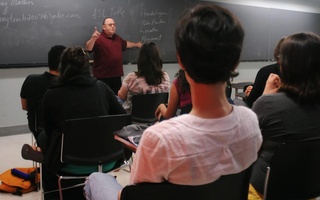
Hand-spelling out the acronym for the American Repertory Theater would be an easy feat for ASL translator Mikey W. Krajnak, who is currently translating “Marie Antoinette.”
The American Repertory Theater’s production of “Marie Antoinette” is a spectacle befitting its opulent inspiration, filled with both flamboyant costumes and intricate wordplay. Alice S. Austin and Mikey W. Krajnak—who provide audio description and signing for blind and hard-of-earing pations of “Marie Antoinette”—acknowledge that the historical complexity inherent to the show makes for a unique set of challenges. Austin, the audio describer for the show, gives an account of the play’s action to its blind audiences with a detailed running commentary of all the action on stage. Krajnak, who currently works as the A.R.T.’s American Sign Language (ASL) coach, coordinates the translation of the show’s sound into a complex visual grammar. Both are integral parts of the A.R.T.’s initiative to supply audio description and ASL interpretation for its shows. This season, the A.R.T. will provide these features for three of its upcoming productions: “Marie Antoinette,” “Pippin,” and “The Glass Menagerie.” Austin and Krajnak’s see themselves as translators as opposed to interpreters, and they seek to render faithful versions of the original shows through radically transformed means.
According to Anna C. Fitzloff, the director of marketing and communications for the A.R.T., the company began putting more effort into ASL interpretation and audio description after these efforts were so well recieved during last year’s production of “The Gershwins’ Porgy and Bess.” “It was so successful,” Fitzloff says. “We had tremendous response from the community. One woman travelled from San Francisco to see the show.” Fitzloff adds that the ASL interpretation was also well received by the members of the community who are not hard of hearing, noting that one subscriber approached her after the show to praise the signing.
Krajnak doesn’t think he’s succeeded, however, unless his translation of the production is as true to the original as possible. “My responsibility is to understand the vision of the show. I’m trying to get a firm grasp on that because that governs everything else,” he says. As an ASL coach, Krajnak will seek out qualified interpreters whose style best fits the production, a role that Fitzloff compares to that of a casting director. Austin follows a similar model; to prepare, she’ll research the show and see the production multiple times in order to develop a script. “I’ll write a script at home and practice it for timing and accuracy,” she says. “I actually attend a general production like any other, and I practice to myself,”
Krajnak’s views on the importance of direct translation stem from working as an ASL coach on a production of “The Sound of Music.” He had put an enormous amount of work into the show, which included translating iconic songs like “Do-Re-Mi” into ASL. “The audience said, ‘I enjoyed it,’ but they asked, ‘Is this like a new show?’” Krajnak recalls. “I realized that I had failed in that part. I didn’t listen to the audience. They’re paying tickets to see the show but they didn’t get what they needed.”
Since then, Krajnak has been more attuned to the difficulties of translation, and part of this difficulty stems from the fact that ASL is a language unto itself. “It has its own syntax, not only in America but all over the world,” he explains. For “Marie Antoinette,” he chose to directly translate the play’s many puns and double entendres, instead of simply capturing the gist of what is being said. According to Brendan P. Shea, an education and community programs associate at the A.R.T., that decision was informed by conversations Mikey had with his audience. “They said this is what we want, and that if it’s translated, we’re not getting the whole thing,” Shea says.
This emphasis on fidelity also crops up in Austin’s job as an audio describer. She must give her listeners linguistic clues that they will be able to decipher in the same way a sighted audience interprets visual information. To do this effectively, she must make sure her descriptions are as aesthetically interesting as possible, a task she names as one of her biggest challenges. “I can’t say that someone has an angry expression or a sad expression. I have to use words like a furrowed brow or a downturned mouth,” she says.
Krajnak has his own linguistic challenges. Since ASL is a relatively new language, its vocabulary often reflects modernity in a way that can be jarring for historical plays like “Marie Antoinette.” According to Krajnak, the sign for the city of Paris resembles the Eiffel Tower; iconic, surely, but also nonexistent in the eighteenth century. To ensure his translation’s authenticity, he needed to find a replacement. “We researched and we found that there were some basic signs for Paris,” Krajnak says. “You have to sign a P in the middle of the hand.”
Such details may go unnoticed by the majority of the A.R.T.’s audience when the first ASL interpreted performance is staged. Austin, whose voice is piped into headsets from the stage manager’s booth, will be even more imperceptible. Yet the reactions to these efforts that the A.R.T. has received, Fitzloff says, is enough to continue them. She attributes the success of the A.R.T.’s program to its reliance on skilled performers such as Krajnak and Austin.
“We didn’t have a program we adopted,” Fitzloff says. “People came to us who were experts in their field and said this is the best way to do it.”
—Staff writer Petey E. Menz can be reached atmenz@college.harvard.edu.
Read more in Arts
"The Words" Stumbles Over SentimentalityRecommended Articles
-
Reaching for the World--Cup, That IsGreg Kenney is perhaps one of the best professional soccer goalies in the United States. Harvard men's soccer Coach Mike
-
Deaf Performance Entices the SensesPeter Cook stood on the center of the stage, the audience circled around him. He pointed to the left side of the room and twenty pairs of arms immediately went up in the air.
-
 Signing up for Sign Language
Signing up for Sign Language -
 Register for Weekly American Sign Language Classes
Register for Weekly American Sign Language Classes -
Students To Vote on Reintroducing American Sign Language CoursesStarting on April 21, undergraduates will be able to vote on whether or not to support the reintroduction of American Sign Language courses that may be taken for credit.















